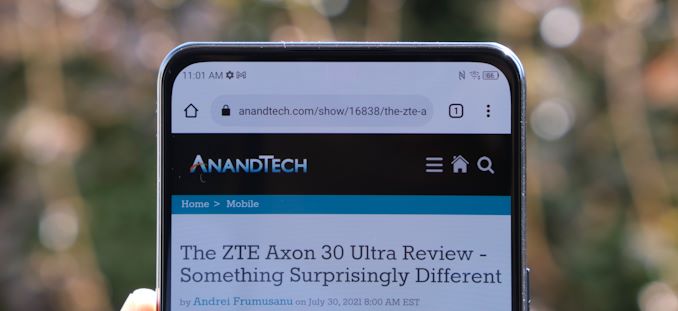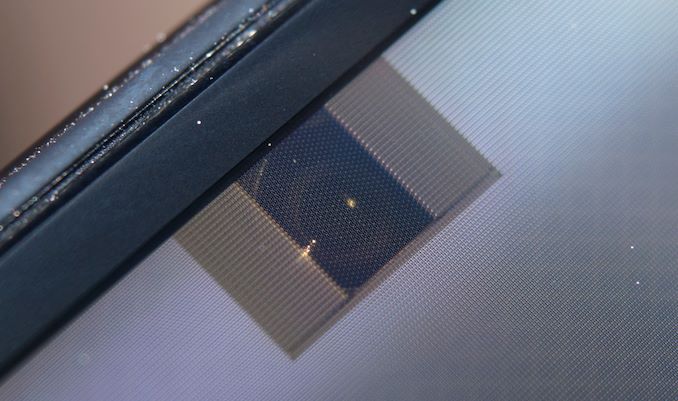The Axon 30 with Under Display Camera: Hands-on Mini-Review
by Andrei Frumusanu on September 3, 2021 9:00 AM EST- Posted in
- Mobile
- Smartphones
- ZTE
- Axon 30
Conclusion & End Remarks
The Axon 30 is an interesting device, both in terms of specifications and also in terms of product category. First and foremost, I had to keep reminding myself that this is a $499 phone, and that’s also a quite important aspect of the device for US readers who usually have extremely little options in that price segment.
Design wise, it’s a relatively generic phone that’s more defined by its size than anything else; with a 6.92” display and 77.8mm body with, it’s a large footprint phone even though it manages to keep things quite reasonable at 189g. Build quality is decent but generally below that of the smaller, higher-end Axon 30 Ultra – which is actually not much of a surprise.
Performance of the phone is great, thanks to the still very competent Snapdragon 870 chip. Peak performance isn’t at S888 levels, however this chip is more power efficient and manages to keep the device cooler than the Axon 30 Ultra.
The defining characteristic of the device is the under-display camera and the screen by Visionox which enables it. There are two large conclusions to be made here:
Firstly, the visual implementation of the UDC is amongst the best we’ve seen so far. While not perfect, the phone manages to hide its under-display camera extremely well. If ZTE manages to even out the brightness differences between the UDC area and the regular panel when viewing the phone head-on, I would say that essentially, you’d be hard pressed to see it anymore.
From a camera quality perspective, I had low expectations, but I was actually still surprised at what ZTE managed to achieve thanks to software processing. Essentially, the camera acts as a 4MP unit, which is quite low res, so you should not really expect great details. Dynamic range and textures are also quite below the norm, however compared to the raw output of the camera, you can’t help but respect the image processing that the phone is achieving.
Overall, if you’re the kind that looks to hide away the front camera to achieve the bezel-less look, I think the Axon 30 is a success. If you still value camera quality – we’re not quite there yet.
The second conclusion of the UDC is related to the display panel itself. It’s the first time we’ve tested a Visionox panel, so I wasn’t sure what to expect, but I had rather low expectations. In terms of brightness, the panel is extremely competitive, however that’s about it when it comes to the positives. The panel differs quite a lot from the usual OLED contenders – when looking at it from extreme angles you can see the polariser shimmering in viridescent colours, something I haven’t seen in many years. The pixel layout, while not exactly visible to the eye, also does feel somewhat less sharp than the regular diamond pentile we’ve gotten used to from Samsung.
One could live with the aforementioned aspects; however, the large deal-breaker is the unsatisfactory power efficiency of the panel. At 423nits brightness, the phone uses 2.87W of power, which is significantly worse than Samsung Display OLED panels (S20U – 2.4W, S21U, 1.8W) Much like the many phones that got ruined by inefficient displays in the past, it also looks like the Axon 30 is also suffering from a larger battery life hit due to the display.
Given the choice of a UDC with an inefficient screen, or a hole-punch with an efficient screen, I’d always choose the latter.
Overall, I think the Axon 30 is an interesting phone, but I can’t help feel it’s still more of an immature technology showcase rather than a refined product. I think the Ultra sibling is still a much better phone, but at least ZTE is pricing the Axon 30 at a quite reasonable level.












24 Comments
View All Comments
Sharken03 - Tuesday, September 7, 2021 - link
I am certainly going to have UDC on my list for the next phone, so i think you underestimate the interest for this feature.It is the end goal for displays to not show anything but the display and it's getting better each day.
Spunjji - Tuesday, September 7, 2021 - link
They can do that just find by having the camera above the display... then you don't have to have a crap camera.nicmonson - Friday, September 3, 2021 - link
Andrei,Deiter at the Verge hated the under display camera more because of the shimmering it caused on the screen than anything else (see his Fold 3 review). He would have wished just to have a black hole as it tends not to distract.
Do you Andrei find it annoying too? Would you rather just have a black hole if they both magically had the same image quality? Is it any better or worse than the Samsung implementation? Never seen one my self so I am curious about your experience.
Andrei Frumusanu - Friday, September 3, 2021 - link
He's talking about the very low pixel density Fold3 UDC, which has a very different design than the one here. There's no shimmering or anything annoying here beyond noticing that the area is a little brighter.sabot00 - Friday, September 3, 2021 - link
Andrei,Your quite positive Axon 30 Ultra review came out a bit after the July Android Phone recommendation article. Would the Axon 30 Ultra place on that list? I'm thinking specifically about the US and I'm on t-mobile (I heard Verizon is not supported).
Andrei Frumusanu - Friday, September 3, 2021 - link
While that phone was generally positive, I wouldn't recommend it in the guide over an S21/S21+ or even S20+.** A - R ** - Saturday, September 4, 2021 - link
Andrei,I reside in Qatar, & here We have Exynos2100 S21s.
As of now Samsung UAE has officially recalled all the S20 FE Exynos 990 (SM-G780F). Now We Officially have S20 FE 5G & 4G both are SD865, models are SM-G781B & SM-G780G respectively. Our CSC/Product Code is XSG.
My colleague is asking Me to suggest one as an Overall great package in sustained performance of the phone. Which one will be a better choice S21 (E2100) or S21 (E2100) or S20 FE 5G or 4G ? And is there any difference in samsung's ufs 3.1 paired with lpddr5 (uMCP) in 128GB ROM vs 256GB ROM ? as I read itbon their semiconductor site for 128 850MB/s writes & 256/512 1200MB/s.
And personally I'd like to know Andrei, that, what is the Actaul difference between the SM-G781B & SM-G780G ?
What has Samsung done in reality, as I remember Qualcomm mandated 5G Modem with SD865. Now did samsung added it in the g780g with giving no Command via Software or did they entirely removed Qualcomm 5G modem & put their's (Exynos Modem) ?
1az2sx - Sunday, September 5, 2021 - link
Hello Andrey! I'm impressed with the work you've done! And you couldn't pass the Pixel 5 vs. Pixel 4a camera test. Does this image processing chip, which is in the Pixel5, and which is not in the Pixel 4a, do anything.eastcoast_pete - Sunday, September 5, 2021 - link
I am probably the odd one out here, but why not make the selfie cam a (small, maybe 1.5-2 mm) hump that extrudes from the screen, instead of a notch. Having the front camera in a notch also limits what kind of lens setup one can have over that sensor (one does need at least a little distance for those lens elements to work), so, if selfies are really that important, why not owning up to it. Plus, no more notch!Calin - Monday, September 6, 2021 - link
The macro camera is my most used.The camera in the current phone is leaps and bounds above the camera in the previous phone, and yet I prefer to use (and prepare) a 10+ years old DSLR.
However, the macro camera sees a lot of use as a magnifying glass for all that otherwise impossible to read smallprint on basically anything in brick-and-mortar shops.